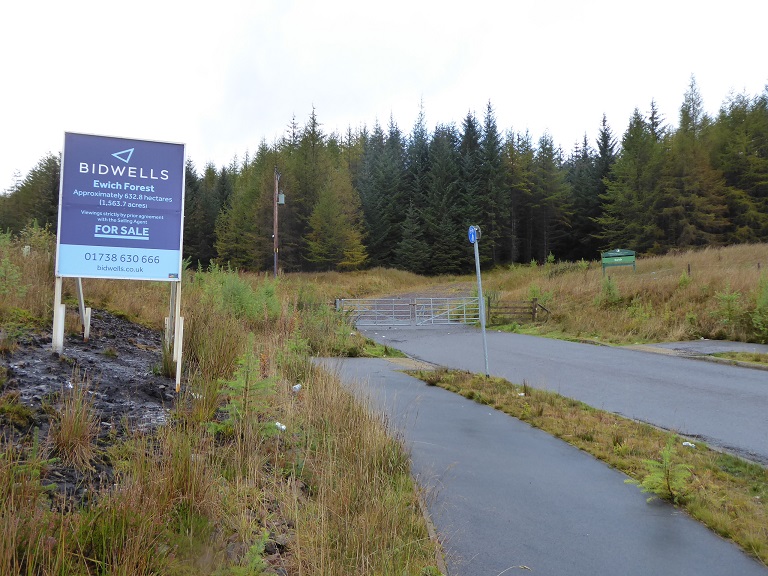
On my way north on Saturday I noticed that Ewich Forest, which is currently owned by Forest and Land Scotland, has been put up for sale. Ewich Forest is the block of conifer forest which extends from Crianlarich north along the west side of the A82. The West Highland Way traverses the forest from Crianlarich to where it crosses over the A82 to Kirkton on the other side of Strathfillan.
Background to sale
I had recently wondered why Forest and Land Scotland, the agency which now manages the publicly owned forest estate in Scotland, had not consulted on a new Forest Plan for Ewich Forest when it has been consulting on plans for the forest plantations south of and east of Crianlarich along Glen Dochart (see here). The answer, it transpires, is that like Scottish Enterprise and Flamingo Land at Balloch, FLS has decided to try and sell off public land in the National Park to private interests.
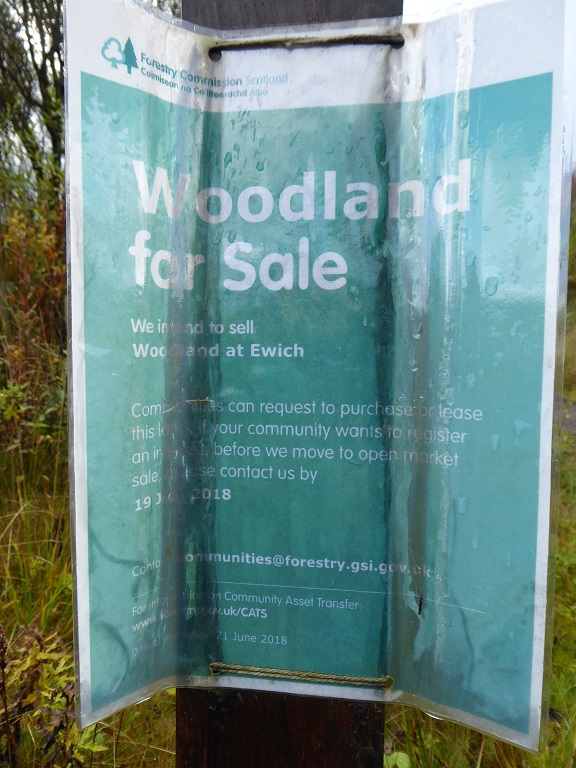
The sale appears to have been advertised to the local community a year ago. Purchase of the Ewich Forest was on the AGM agenda for the Strathfillan Community Development Trust in November 2018 and is on the agenda again for their AGM this year. However, I can find nothing more on their Facebook Page or the Stathfillan Community Council website (see here) about the sale and it looks like there is little prospect of a community buy-out.
The photographs on the Bidwell’s brochure (see here) are dated July 2019 and it appears the forest has been put on the market in the last couple of months.

Much of the forest is now “mature” and ready for felling, hence the selling price.
Ewich Forest and the West Highland Way
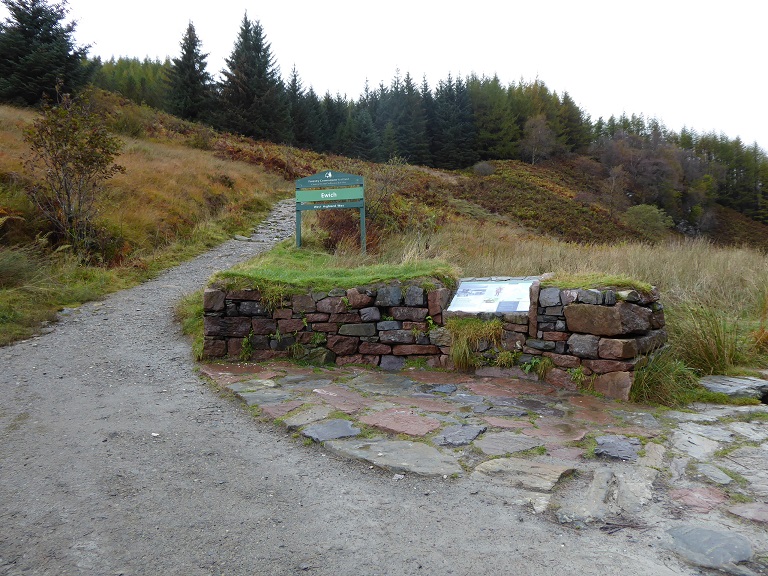
Few forest plantations in Scotland have been planted around the needs of walkers and all too many form impenetratable blocks. Ewich Forest was, however, designed to incorporate the West Highland Way according to the best practice of the time. To provide interest to walkers a variety of tree species were planted, mainly sitka but also larch, lodgepole pine and rowan. This only went so far as, despite its name (eigheach = yew in Gaelic), no yew were planted and relatively few native trees.
A broad tree free break was designed through the forest to provide a route for the West Highland Way, with further breaks in the forest below to provide views. Initially there was no path and the first guide to the Way described the route as being hard to follow through rough tussocks of purple moor grass. The trees subsequently grew to form a clearly defined ride and then a path constructed, one of the first in Scotland to use mechanical diggers.
Ironically, while being the largest purpose designed and built section of the West Highland Way, Ewich Forest has provided one of its least satisfactory walking experiences. While the surface is pleasant to walk on, this 4km section is generally enclosed, with few opportunities to look out over the historic through route of Strathfillan, and of limited wildlife interest. There are just two viewpoints, from which you can see the Crianlarich hills and along Glen Dochart but the hills and strath are an intermittent rather than a constant presence and there is little pleasure in lingering. Its not what one would expect for a route promoted worldwide as providing a high class walking experience. The felling of Ewich Forest could therefore have provided an ideal opportunity for Forest and Land Scotland and the Loch Lomond and Trossachs National Park Authority to improve it.
Instead its being flogged off through Bidwell’s. There is not a single mention of the West Highland Way on the Bidwell’s sale web page. The fact that a world famous walking route passes through the forest appears of no account. Nor is the fact that its a core path. This is important because just who will be responsible for maintenance of this section of the West Highland Way in the future is unclear. Does Forest and Land Scotland expect this to pass to the new landowners and, if so, would legally binding agreements be put in place to ensure that the Way is properly maintained? If not, what will happen to this section of the Way?
Bidwell’s brochure strongly suggests that NO account is being taken in the sale of the potential to improve the recreational experience. The brochure indicates that an Environmental Impact Assessment has granted approval “for the construction of 6.5km of new forest roads and associated quarries”. It also states that:
“the prospect of restructuring areas of larch and lodgepole pine with more productive conifer species presents itself over significant sections of the site, subject to the necessary permissions”.
In other words, instead of diversifying the woodland, which would help improve the walking experience, Scottish Forestry, the regulator for forestry in Scotland, would be quite happy to see this forest turned into an even more monolithic sitka plantation. That is terrible news for walkers and contrary to the statutory purpose of the National Park to promote the public’s enjoyment of the countryside. If our public agencies are incapable of doing this along the West Highland Way, that’s further confirmation that recreational interests now come second to commercial interests in signficant sections of the National Park.
The Ewich Forest sale, nature conservation and the LLTNPA
Converting Ewich Forest to even more “productive conifers” is also terrible news for nature conservation in the National Park.
In its draft Trees and Woodland Strategy the LLTNPA set out objectives for diversifying existing conifer plantations. The final strategy is being presented to the LLTNPA Board for approval on 24th October and has been tweaked slightly. Here’s what it says about conifer forests such as Ewich.
“The key enhancements that management of productive conifer forest should deliver are:
- Creating landscape-scale woodland habitat networks across ownership boundaries incorporating prioritised areas (including Plantations on Ancient Woodland Sites PAWS) for native woodland conversion and use of Low Impact Silvicultural Systems (LISS).
- Extending age class diversity throughout a forest to optimise structural diversity and extend economic opportunities.
- Manage herbivore impacts to sustainable levels for timber production [reference to timber production added. This changes the meaning and means herbivores no longer being managed for conservation purposes].
- Enhance the contribution of forests to the landscape character and cultural heritage through design of the felling coupes, use of LISS and replanting proposals which maintain species and visual diversity.
- Careful planning and construction of forest roads and other infrastructure.”
There is no sign that any of these objectives have been incorporated into the sale of Ewich Forest. Instead, Forest and Land Scotland has continued to do its own thing and sell off areas of public land without any consideration of the Strategy, to which they are supposed to be partners, or the consequences.
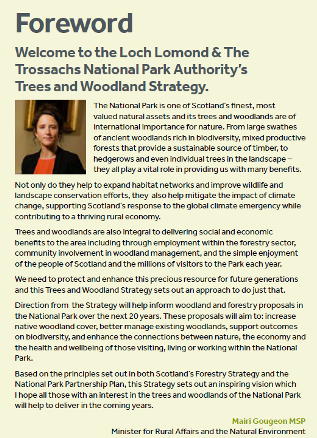
Unfortunately the Minister for the Natural Environment appears unaware of what is being done in her name.
As Parkswatch has previously argued the LLTNPA Trees and Woodland Strategy is not a strategy at all but rather guidance (see here) which is unlikely to deliver any meaningful change. The sale of Ewich Forest confirms that. Indeed it shows that the management of forests in the National Park could get worse, not better.
One would hope that the sale of Ewich Forest would cause considerable embarrassment to James Stuart, Convener of the LLTNPA, who earlier this year was appointed as an adviser to the regulator, Scottish Forestry. It would appear that his appointment has had no impact as yet on forest practice within the National Park. It will be interesting to see what if anything he does to argue that this public land should not be sold off and should be managed to principles set out in the Trees and Woodland Strategy.
What should happen at Ewich Forest?
Scotland’s National Parks are unusual in that much of the land within them is not publicly owned. This accounts for many of the difficulties both our of National Park Authorities have had in ensuring land is managed sustainably, for conservation and recreation and for the benefit of local communities. Whatever the historic situation, however, there is no excuse for our public agencies to make these challenges worse by selling off even more land to private interests. And yet that is what happening at Ewich Forest. Its time that the Scottish Government made a public commitment to keep all public land in our National Parks public, starting with Flamingo Land at Balloch and Ewich Forest in Strathfillan.
Second, Forest and Land Scotland needs to be told to put in place a plan to enhance the recreational experience in Ewich Forest and the West Highland Way in particular.
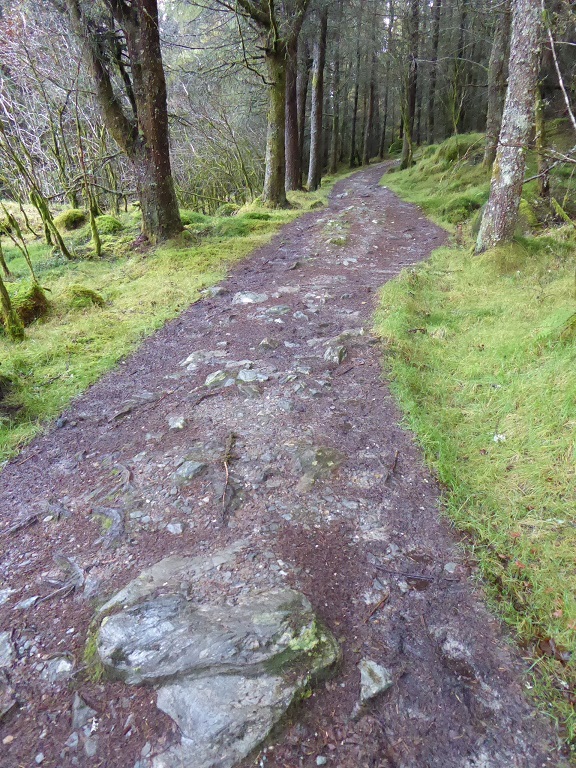
That needs to be done in conjunction with the local community – who have been involved in the creation of a bike skills track at Tyndrum – and recreational organisations like Ramblers Scotland. Diversification of woodland along the West Highland Way and the creation of more open areas which would allow views out over historic Strathfillan would greatly improve the walking experience. At the same time there is a need to put in place plans to ensure that any felling operations do not result in any temporary closures of the Way (as happened to the core path between Tarbet and Arrochar (see here)).
Third, the felling of Ewich Forest provides a huge opportunity to link up the remnants of native woodland in Glen Falloch with that in Strathillan. The LLTNPA’s Trees and Woodland Strategy states that the National Park wants to create woodland habitats networks yet the conifers at present create a large barrier between the Caledonian pinewoods in Glen Falloch and Coire Chuilc, under Beinn Dubhcraig to the north. The Strathfillan Community Development Trust created a community woodland just to the north east of Coire Chuilc and south of Tyndrum so why not extend this to Crianlarich instead of replanting with Sitka as appears to be proposed?
Fourth, Forest and Land Scotland claim on their website to:
“work closely with local communities to ensure these forests balance the economic benefits of jobs and timber production with the social and environmental benefits of being pleasant, welcoming places to visit”.
While its not clear what discussions have taken place with the local community about Ewich Forest, it does appear that instead of resourcing the local community to help them get involved in managing the forest (and create locally based jobs) FLS has decided to sell off the land. Unfortunately, most of the Scottish Government’s talk of Community Empowerment is hot air. Communities are presented with choices, either take over the land or…………nothing. There is very little inbetween. The resources required to take over the management of land are far more than most local communities can manage and are a recipe for volunteer burn-out. Imagine trying to raise £5.75m. In the case of Strathfillan Development Trust both last year’s and this year’s AGM agenda indicate that all Trustees wish to resign. The Scottish Government needs to re-think how community empowerment applies to the land and increase the means by which local communities can have a say over how it is managed without assuming financial responsibility for it.
Where next?
Instead of being sold off, Ewich Forest could provide a model for how conifer forestry plantations in the National Park could be improved, whether for outdoor recreation, conservation or the benefit of local communities. The LLTNPA should, if it was worthy of the name, be at the forefront of that process. Unfortunately, I suspect its going to take a massive public campaign – as is happening with Flamingo Land – to prevent the land being sold and put an alternative plan in place. That will require recreational and conservation organisations to join forces with people in the local community.

True they offer to communities, but the process is geared up to fail. There is no real support for the thousands of hours of time the volunteers must do to get the process done, then they expect the community to fund much of it themselves when it was already a tax payer owned forest in the first place. You couldn’t make it up, how twisted and incompetent this government has become. Thy simply don’t want communities to own these assets despite their propaganda.
You make great points, but your wrong on one point – our environment minister Rosanna Cunningham and cronies are behind the entire destruction of our national assets. When the tories tried to sell off the forestry commission, millions protested and they listened and stopped. but when the SNP started selling off the forestry commission, no one cared because we are brainwashed into obsessing over independence and never challenge the idiots wrecking our country.
The FCS have lost all control of our forests in every way that matters because the SNP have slashed their budgets now they have more powers and our wildlife is disappearing – an ecological meltdown in front of our eyes. Deer populations so high that nothing can survive insects, flowers native tree saplings. Scotland deserves better. Our children deserve better. Where are the flowers, the insects, the birds, nothing but deer and exotic conifers – and even they are not allowed to mature and offer any wildlife value as they age and die off.
I am curious as to the status of the West Highland Way, if the land the WHW runs through is sold what guarentees are there that new owners will respect our right to walk there? At the Craigallian estate there have been frequent clashes between walkers and the new owners who seem intent on restricting access.
John, access rights apply to WHW and as for almost all land except private gardens around people’s houses so if there are issues at Craigallian the Council should be taking those up with the landowner. WHW is also unusual in that it was designated as a Long Distance Path under the Countryside Scotland Act 1967 before SNH decided to stop designating new LDPs. Before being designated the then Countryside Commission had to set out proposals for its maintenance and management. The problem is that clarity about that responsibility has since been eroded by various government organisations and the Loch Lomond and Trossachs National Park Authority is now the lead body but took c3 years to publish a report on management options for the WHW and has, since then, I believe done not much (I will check). What alarmed me was that in the sale documents there was no mention of responsibility for managing the Way: will Forest and Land Scotland retain responsibility or will the National Park take this over if the land is sold? In either case there would presumably need to be a new legal agreement with the new owners. You have prompted me to follow this up with the LLTNPA, thanks, Nick
Having being brought up in Crianlarich from early the 1950s I for one will be so glad to see the pine trees felled. I will tell you the reason. When I was growing up I enjoyed seeing all the wildlife that lived around the peat bogs and the river area. The hillside was grazed by sheep. The wide range of birds there included Lapwings, Sky Larks. Meadow Pipins, Grouse, Snipe to name a few. When the hillside was ploughed for the trees and the peat bogs were drained. The wildlife habitats were destroyed and all the wild flowers had nowhere to grow. The Fillin river had meadows and an abundance of numerous types of wild flowers. When there were periods of heavy rain the peatbogs and spagnam moss beds acted as a sump and released the water from the rain slowly giving the river time to drain and not rise to flood levels so frequently. Draining the hill ground causes the river the rise to flood proportions every time there is heavy rain. The river banks were nesting areas for Sand Martins who made their nests in burrows. They don’t come anymore, flooded out. The Crianlarich hotel used to crop the meadows with Grain, potatoes, turnips and hay to feed the milking cows that grazed there. There were walks along the river with railway sleeper bridges over the burns and ditches. Land needs to be managed and grazed to mentain the flora. People think letting land return to nature as has happened on the river side is the eco solution. . All that happens is rough grass and scrub take over and it becomes no use to wild flowers, birds and animals. The west Highland Way path can still be there and what a view will be had when all the killer pine trees are gone. The wild life and flowers are gone and won’t return. The river and hillside is changed for ever.
Unfortunately, the sale of Ewich forest was marketed as an opportunity to plant more sitka, so unfortunately I don’t think the felling will result in a return to how the area was in the 1950s. Your description of that time and how low intensity farming helped was good for wildlife is fantastic. I disagree with you though that they couldn’t return, that is exactly what our National Parks should be for and Crianlarich has fantastic potential. Unfortunately at present the National Park is going in the opposite direction, failing to intervene in forest sales such as this allowing the Cononish gold mine development to dig and destroy peat